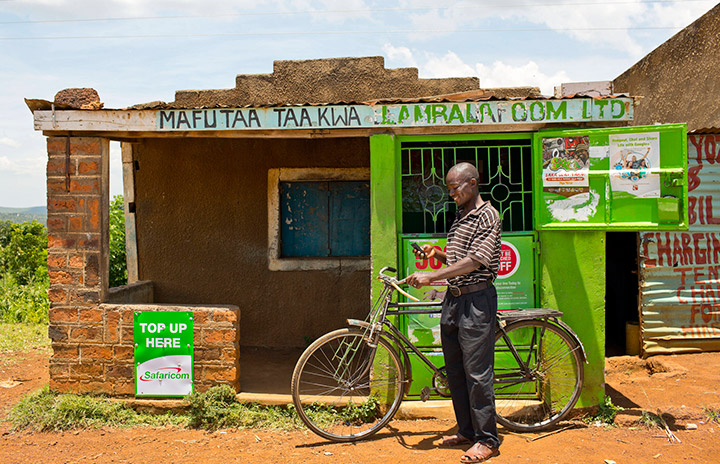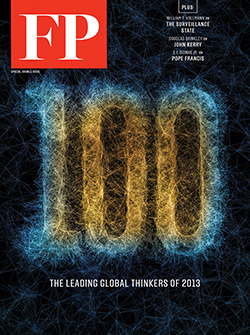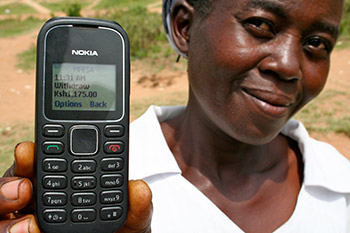
By:
- Inga Kiderra
Published Date
By:
- Inga Kiderra
Share This:
No Strings Attached
GiveDirectly nonprofit tries unconventional approach to helping those in need

GiveDirectly’s no-strings-attached donations are deposited through a mobile banking system straight to a recipient’s cell phone. Image courtesy of GiveDirectly.org
GiveDirectly is a nonprofit that does something radical – almost heretical – in the world of international charity: It gives cash directly to those who need it without any strings attached.
Each donation is about $1,000, deposited through a mobile banking system straight to a recipient’s phone. In Kenya, where the group began operations, this is equivalent to a year’s wages. The windfall is not a loan. And what’s required in return is exactly nothing.
Paul Niehaus, an assistant professor of economics in UC San Diego’s Division of Social Sciences, is one of GiveDirectly’s co-founders. He and three other development economists started GiveDirectly in 2008 while they were still graduate students at Harvard and MIT. Cash transfers have been gaining popularity in development circles since about 2000. Today, about a billion people in developing nations receive monetary aid, but it is usually conditional. Niehaus and his colleagues wondered: What would happen if they just let impoverished people decide how to spend their cash?
“I believe we should be putting more money and more power directly into the hands of the poor,” writes Niehaus in a blog post. “When given the chance, they have a consistent track record, across dozens of rigorous studies, of using money sensibly to improve their own lives.”

Paul Niehaus
“Poor people have good ideas,” he adds when interviewed. “And they need to be part of the conversation.”
That sentiment goes against the popular stereotype of the poor as feckless and irresponsible. And a typical first response to the idea, Niehaus says, is often: “That’s crazy.” Yet it’s also winning the group a lot of enthusiasm and support.
Combined donations to GiveDirectly have reached $8.5 million. The largest single donor to date is Google: The internet giant has invested $2.4 million in the effort, through a “Google Global Impact Award.” Chris Hughes, a Facebook co-founder who is now publisher and editor-in-chief of The New Republic, was inspired to personally give $130,000. He also joined the GiveDirectly board.
GiveDirectly has been operating since 2011. Within two years, a leading charity evaluator named GiveWell – one that looks not only at financials but also at “how much good a given program accomplishes” per dollar spent – rated GiveDirectly as its No. 2 charity. On Dec. 1 of this year, GiveDirectly rose to the No. 1 spot. In recognition of this, Good Ventures announced $5 million in matching funds to GiveDirectly, as well as $2 million in unrestricted support.
Also in December, Foreign Policy magazine named Niehaus and the other GiveDirectly co-founders “Leading Global Thinkers” for 2013. Previous recipients of the honor have included Warren Buffet, Hillary Clinton and Bill Gates. This year’s crop of awards also names Amazon founder Jeff Bezos and the Intergovernmental Panel on Climate Change.
How It Works
How GiveDirectly.org works is simple. The public donates on the organization’s website. Field workers for the nonprofit identify poor households on the ground. What qualifies a recipient is a house without cement or metal walls, floor or roof – a reliable indicator, according to research, of acute poverty. In addition to being easy to verify, this criterion has the advantage of making it straightforward to explain to people why some in their village received cash while others didn’t.
After a satellite-based service has verified a field worker’s report, GiveDirectly then sends the donation straight to a recipient’s cell phone, through a mobile banking system like M-Pesa. About 92 cents of every dollar that GiveDirectly gets is sent on to the poor – a remarkable ratio.

The recipient then gets to choose how to spend the money.
Common uses of the cash in Kenya have included installing a tin roof to replace a thatched one (which, it turns out, is surprisingly costly to maintain) and starting or expanding a business. Businesses have ranged from rearing chickens to vending soap to operating a motorcycle taxi service.
GiveDirectly began operations in rural Western Kenya, where per-capita income hovers around $1 a day and 64 percent of the population report not having enough food in their house for the next day. It has recently begun work in a second African nation, Uganda, and is now looking to possibly expand into South Asia.
NPR’s “Planet Money,” PRI’s “This American Life,” the Atlantic, Slate, and New York Times “Economix” blog have all reported on GiveDirectly’s work in Kenya. Reporters who visited with recipients write glowingly about what they’ve witnessed.
But even better than these anecdotes, or plaudits and media attention more generally, Niehaus says, are the results of recently released research.
Beyond Anecdote: The Data
Early in 2013, GiveDirectly publicly announced that a third-party assessment of its Kenya efforts was in the works.
The study is a randomized controlled trial, the gold standard in both science and medicine. It was conducted in collaboration with the nonprofit Innovations for Poverty Action and funded by the National Institutes of Health Common Fund. About 500 men and women received $404 each. The gift was delivered either in a lump sum or in monthly installments over the course of 9 months. Another 500 people in the same villages served as controls. An additional 500, in other villages, were studied for comparison. Of the 500 people given money, 137 received additional gifts, bringing their total to $1,525. (Note: Dollar amounts are purchasing power parity adjusted.)
The results include: Recipients’ assets increased 58 percent, primarily through home improvements and increased livestock holdings. Business and agricultural income increased by 28 percent of the average grant size.
There was also a 42 percent reduction in the number of days children went without food. And domestic violence against women fell in both treated households and their near neighbors.
There was no evidence of money wasted on harmful pursuits or “temptation goods” such as alcohol and tobacco.
But perhaps most interesting and significant is that mental health improved substantially. According to validated psychological scales, there were large reductions in stress and depression, along with increases in life satisfaction. There is even some evidence, as measured by saliva samples, that larger transfers lowered levels of the stress hormone cortisol.
“There is this growing realization that being poor is really stressful, and that that can make it hard to organize your life and plan and make good decisions,” Niehaus told “Planet Money.” “If one of the things that giving people wealth is doing is enabling them to feel more sane and more in control of their life, that could ultimately be one of the more important things.”

Image courtesy of GiveDirectly.org
Fish and Fishing Lessons
Niehaus doesn’t see unconditional cash transfers as a panacea or the only solution to poverty. Conditions have their place. As do other forms of aid. But he thinks they are an important additional tool for development schemes, and the evidence that they are effective is mounting.
“Catch phrases seem intuitive,” Niehaus says. “‘Teach a man to fish’…and so on. But reality is there isn’t much evidence our fishing lessons work.”
Sometimes, Niehaus suggests, when the reason for poverty is little more than being born in Africa, giving a man, or woman, a fish may be the way to go.
In the future, Niehaus would like for GiveDirectly to become a benchmark for charitable giving: Both evidence-based and doing more good than it costs.
Because GiveDirectly is working with a technology platform for donations and because it can identify and solve problems more nimbly than large bureaucracies, he also hopes that it will be able to offer a package of solutions to government programs in the developing world that struggle with mismanagement and corruption.
“People now are paying attention to what we do,” Niehaus says. “I would hope in 10 years or so that they’ll know us more for how well we do it.”
To learn more go here.
Share This:
You May Also Like
Stay in the Know
Keep up with all the latest from UC San Diego. Subscribe to the newsletter today.


